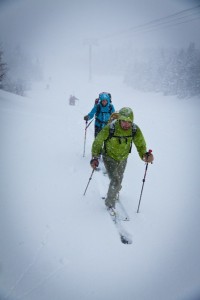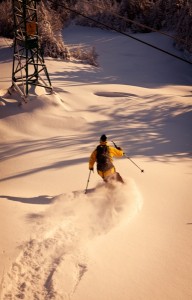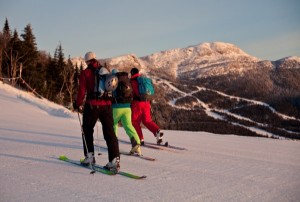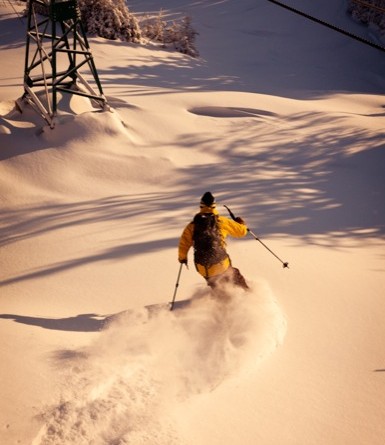Skinning Dipping | Resorts Respond to the Growing Interest in Uphill Travel

Skinning was once a niche activity practiced only by adventurous backcountry skiers seeking out uncrowded powder slopes far from the crowded lifts. But in recent years, the activity—in which skiers and snowboarders apply climbing skins to the bottom of their skis so they can climb up hill without slipping back down—has exploded in popularity, thanks to the advent of easy-to-use and widely available backcountry ski gear.
In fact, the use of skins is becoming so prevalent that I hesitate to use the word “backcountry” here. Recent events and shifts in the market now mean that much of this gear is being used in the frontcountry, to climb up ski resort trails, far from those uncrowded powder slopes. This has presented a quandary for ski areas, where, for many years, there has been uphill travel only via chairlifts.
But there are a number of reasons why a skier might not want to use a lift at a ski resort. Many people are just looking for some exercise in the outdoors, and some are practicing with their backcountry gear in a controlled environment before heading out into real wilderness where a gear failure could be more serious. I often hear of season pass holders at smaller resorts using skins as a new way to enjoy a mountain that they love, but may have grown tired of skiing the same way too often. Or, like me, they skin up ski resorts before dawn or at night because the lifts don’t run during the hours we have off from work and family.

While there are several good reasons for enjoying a skin up your local ski resort, there are many risks, several of which are not entirely obvious to most skiers. This intersection of the usually unticketed and unaware skinner population with the litigation-wary and business-minded resort management (that has bills to pay) has caused significant debate in recent years. Do ski resorts respond by stepping up enforcement and keeping skinners off their slopes, or do they embrace this new surge and try to bring skinners into their fold? Resorts that had never considered an “uphill travel policy” are now drafting and posting rules to clearly state their intentions. Other resorts that have had official uphill travel policies have been revising them and reaching out to the skin-to-ski community to communicate their rules and expectations.
Mad River Glen has long been known as friendly to uphill traffic. Usually in the pre- or postseason, or for ticket-purchasing snowshoers, but in an official newsletter last winter to co-op members, mountain management wrote, “Over the past couple of seasons we have seen a major uptick in the number of folks skinning up the mountain, generally, and when we are running the lifts in particular. Because of the increased potential hazards with downhill traffic and mountain operations, we have decided to enforce the [previously unenforced, though, official] policy of not allowing skinning during operating hours going forward. … We hope that you can appreciate our safety concerns in regard to this issue.”
A similar policy is in effect at Smugglers’ Notch Resort. Karen Boushie, public relations at Smuggs, told me, “Our policy is that we allow uphill traffic when we are not open for skiing or snowboarding. We request that people not use trails that are groomed or have operations in progress.” She added, “We updated the policy last year … because there were a few individuals exhibiting dangerous behavior such as skiing under winch cables, skiing on trails with zero visibility, and skiing behind snowcats in the dark. We have posted this publicly in our parking lots at night.”

Bolton Valley Ski Resort goes one step further and officially prohibits uphill travel on their downhill trails at any time. When I asked Josh Arneson, director of sales and marketing at Bolton, if he foresaw any debate or change in this policy going forward, he said, “I do not foresee it changing anytime soon. … Uphill traffic on an Alpine run is dangerous. The downhill skier or rider is not looking for uphill traffic, so it poses a risk to both the downhill and uphill skier. We have 100K of Nordic and backcountry terrain that is open for those who want to skin or hike up.”
Stowe Mountain Resort does not allow uphill travel during operating hours and “discourages” it during nonoperational hours. In a letter to the editor in The Stowe Reporter last February, Vice President of Mountain Operations Scott Reeves wrote, “In recent seasons, we have seen a marked increase in off-hours use of our trails. … Stowe Mountain Resort does not recommend the use of our terrain during nonoperational times. However, grooming, snowmaking, and other operations take place 24 hours per day throughout the resort. Skiers and riders must understand that they put themselves at great risk when they come in proximity to these operations.” Reeves continued with several safety tips and etiquette requests for those who might choose to disregard the official discouragement. These tips mostly center on avoiding grooming and snowmaking operations at any hour and making yourself easily visible to all resort staff via headlamps and reflective clothing.
Reeves, and several other people contacted regarding this story, specifically mentioned the danger posed by winch cats. Winch cats are large grooming machines that use long fixed cables to ascend or descend steep slopes. The cables are near invisible in the dark and can be lethal to a skier who hits one. Indeed, Greg Hill, who made international headlines by skinning 2 million vertical feet last year, and recently survived an avalanche in the Himalayas that killed 11 people, suffered his only injury last year when he broke several ribs colliding with a winch cat cable while skiing before dawn at a Canadian resort.
Because of dangers like these, Bromley Mountain does not allow winter access of their trails outside of normal operating hours.
However, unlike the resorts discussed so far, Bromley has an official policy during business hours “not to restrict uphill access to skiers with climbing skins. Uphill access may occur area wide.”
Jay Peak and Magic Mountain have similarly inviting policies for skinners. Steve Wright of Jay Peak Resort recently said skiers may “have at it, just about anywhere on the mountain,” with safety in mind, of course. Geoff Hatheway of Magic Mountain proudly pointed me to the official policy highlighted on their website that reads, in part, “If you pass a skier or snowboarder going the wrong way (uphill) at Magic Mountain, don’t be alarmed! Magic Mountain will be embracing uphill traffic via telemark, Alpine touring (randonee), and splitboard snowboards this season and well into the future. Magic will be offering free access to the mountain for anyone willing to “earn their turns.” … Touring is a complimentary activity.”
When asked further about this policy, Geoff said, “Magic is all about the sport of skiing and riding. We celebrate those who take it seriously, want to be challenged, and are willing to test their limits. Those who climb our hill and ski down may not be providing direct revenue for us, but we also know that they are the type of folks who will probably stop in for a bevie at the bar. Maybe a bite to eat, and tell others what a good time they had at Magic.”
Mount Snow and Stratton have similar policies, inviting skinners to enjoy the mountain. But both resorts ask that skinners check in with mountain operations so they can familiarize themselves with the best terrain for uphill travel.
The response of Vermont ski areas to the rise of resort-skinners is varied from encouragement to banishment. Without fail, every person contacted about this issue highlighted the safety risks involved. I do hope you go out and earn some turns this season, whether in the backcountry or at a resort. Find out the policy before you go, and be safe, be seen, and be considerate of mountain operations employees trying to get their jobs done.
Tips for Happy Skinning in the Frontcountry
Be sure to check out the official uphill-traffic policy of your favorite resort before going.
Remember that the resort company controls access to the trails and bears the liability, even on leased state (public) land. Resort access guidelines on US Forest Service land, such as the White Mountains in New Hampshire, are currently under review.
Be courteous! This includes:
- If you arrive early on a powder day, be sure to park out of the way so the resort can still plow the lot for other customers.
- Control and clean up after your dog. Never bring your dog when lifts are running.
- Don’t litter.
- Do not boot pack in an existing skin track.
Be Safe! This includes:
- Avoid all snowmaking and grooming operations.
- If it’s dark or dusk, wear a headlamp so you can be seen.
- Always stay off of roped-closed trails.
- Ski with a partner.
Be Grateful
- Buy a meal, a ticket, or a pass from the mountain that allows you to skin.



